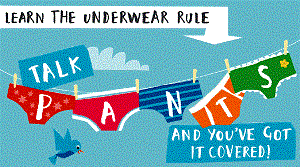NSPCC UNDERWEAR RULE: The protective ‘PANTS campaign’ aims to prevent and uncover sexual abuse of children.
The PANTS rule book teams up with brief radio adverts issued by Council of Europe. Together, they both help parents teach kids the importance of the underpants rules.
The latest CoE children underwear rule uses simple child-style graphics. We Are Talking P.A.N.T.S as other messages in the book guide parents in the prevention and awareness of child sex abuse.
The writers of this children’s book used catchy underpants depictions.
They provides parents and guardians with all the tools they need to get the message through. It provides clear explanations about off-limit touching zones of 3 – 7 year old children. It places emphasis on the appropriate help-seeking responses they should follow.
NSPCC statistics suggest up to 20% of children suffer sexual violence or abuse in the UK each year. Sadly, it happens to toddlers of all ages, social class, religion and gender.
Teach Your Child the NSPCC PANTS Rule
Around 75% of child sex abuse cases involve a known or trusted adult by the child. Teach your youngsters the children underwear rule. They will learn how to recognise the danger signs and how to report child abuse.
P – Privates are Private!
A – Always Remember Your Body Belongs to You!
N – No Means No!
T – Talk About Secrets that Upset You!
S – Speak Up, Someone Can Help!
NSPCC Underwear Rule PANTS Campaign
The NSPCC PANTS rule teaches children not to touch others in any areas usually covered by underwear. The underpants rule reveals the impropriety of touching kids around their private parts.
The rules on children’s underpants explains about good touches and bad touches.
It uncovers the 5 steps in a delicate and child-sensitive tone. The non-intimidating discussion between parents and their young ones cover these five important aspects.

1. You Decide Who Touches Your Body
Teach children that ‘they‘ decide who touches their body – and when. This is one of the most important objectives of the child underpant rule.
The rule emphasizes inappropriate behaviour. It shows how physical contact and kissing without permission is wrong. It is right to refuse permission and say ‘NO‘ with firmness.
The child pants underwear rule campaign and NSPCC book depicts a hand attempting to touch inside the underwear. It uses a pubescent animated cartoon character named Kiko. And Kiko abruptly replies NO!
Parents should explain when parental or professional tactile contact is acceptable. Such occasions could be by a doctor or care worker, for example.
The story-line also encourages children to decide who fondles or caresses their body. Especially in circumstances where the situation is uncomfortable for them.
CoE guidelines provide other suggestions. They recommend parents speak to their children about sexuality early in their development. It is best done using the correct terminology about genital body parts.
2. Difference Between Good and Bad Touches
The NSPCC underwear rules address the topics of appropriate and inappropriate child touching. The underwear’s border clearly defines the boundaries of a person’s private parts. It accentuates the difference between appropriate touching and unacceptable behavior.
3. Good Secrets vs. Bad Secrets
The underwear rule book and NSPCC adverts discuss differences of good secrets and bad secrets. Keeping a good secret could be a surprise child’s birthday party. Whereas a bad secret is something that often upsets a child or makes them feel anxious or fearful.
4. Sharing Bad Secrets With a Trusted Parent
Child sexual abusers use secrecy as a trust-gaining or grooming tactic. Known predators buy gifts for a child and ask them to keep secrets about their relationship. Teach young ones not to accept invitations or gifts from unknown predators or strangers.
FURTHER READING
» How to Report a Rape or Sexual Assault to the Police or SARC
» Parental Responsibility Agreement Rules and Parental Rights
» New Software Tool Used to Identify Online Child Grooming and CSE
But, parents should teach children about confidentiality. It’s important to encourage children to share a bad secret with a trusted adult. The obvious trustee would be a parent, a doctor, a teacher, or a police officer.
5. Adult Responsibility of Prevention and Protection
Creating sexual taboos is likely to make abused children uncomfortable about speaking out. Encouraged toddlers to discuss their guilt feelings and shamed sadness.
The underpants rule book pictures encourage trust and openness. Kiko and the animated hand represent these issues. This signifies respect and responsibility that parents should have towards their children.
It is time for adults to prevent further victims of sexual violence. Protect children from the burden of sexual abuse.
NSPCC Child Abuse Disclosure
It is important that children understand about reporting and disclosure of child abuse. They must have a safety network with trustworthy adults who are ready to listen and help.
In an ideal world, the child’s safety network should include a parent or guardian. If not, perhaps an adult living with the child or an immediate family member outside the home of the child.
If you suspect child abuse you should not be angry with your child or interrogate them. Making them feel like they did something wrong is all too common. Avoid asking the youngster why it happened and try to stay calm around the child.
Avoid rushing to conclusions without clear information. But, make sure the child understands that there is a solution and something can get done. Report the incident to a help center for abused children.
Contacting a childcare or parenting specialist, doctor, or social worker may also be helpful.
Further material and information to help parents teach the Underwear Rule is available from the Council of Europe. You can also visit the website of CoE ‘One in Five’ stop sexual violence against children campaign.

